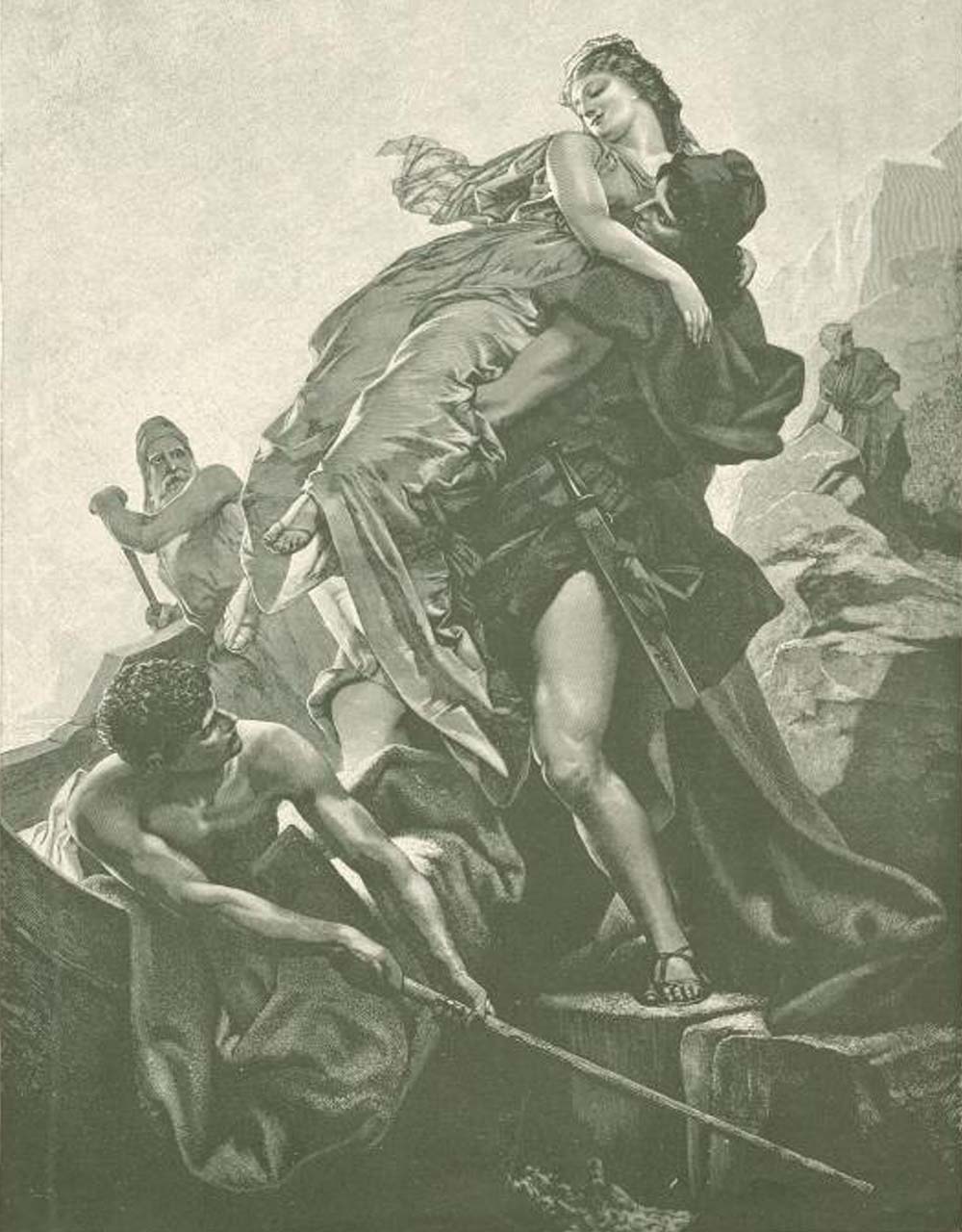
Helen of Troy, by Valerio Belli, sixteenth century. National Gallery of Art, Samuel H. Kress Collection.
Like her patron goddess, Venus, Helen of Troy represents, in Goethe’s famous phrase, the “eternal feminine.” She pervades the broader discourse of beauty culture in the early twentieth century. A newspaper article from 1916 informs us that an artist named Ray van Buren studied “the beauty of Helen as delineated in the finest Greek friezes and sculptures,” before extolling the modern women who, in his view, have “the same classic, tantalizing, heart-storming beauty as the immortal Helen of Troy.” A 1926 tip for lustrous hair (involving egg whites and carbolic acid) is attributed to Helen’s “beauty recipe books.” Her name appears less often than Venus’ in early movie titles, but advertisements for beauty products often invoke the goddess and her protégée in the same breath. Sometimes they are even conflated, as if Helen had been the winner—not just a bribe—at the Judgment of Paris: “The Search for a New Helen of Troy Begins in France, [with] the Modern Judgment of Paris…to Determine Who Is Most Beautiful.”
As icons of female beauty, both Helen and her patron goddess were vehicles for contemporary ambivalence about the cultural legitimacy of modern America. Many sources opine that in Hollywood Helen would be nothing in comparison with the abundance of American beauties. Despite Ray van Buren’s enthusiasm for Helen, he contrasts her singularity in her own day with the alleged fact that “the measurements of fifteen hundred girls at Wellesley College average approximately the classic lines of Venus de Milo.” As a pagan goddess, however, Venus can enter modern life only in magical or symbolic ways. Like other such divinities, she is of interest primarily as a force that rules mortal lives or brings the human condition into focus through (often humorous) contrast. Helen, on the other hand, stands at the center of a narrative that can, if necessary, be stripped of the supernatural to become a strictly human love triangle.
With few exceptions, ancient reports of Helen’s divinity are ignored in this early twentieth-century discourse. Opinions on her historicity diverged: though naysayers continued to consign her to legend, proof of her historicity was eagerly sought and often found. As one newspaper headline from 1924 proclaims, helen of troy real—not a myth. “Science” went “dredging for relics of the world’s greatest vamp,” and managed to unearth such artifacts as “Helen’s safety pins.” There is endless speculation as to what she “really” looked like, especially her hair color (was she a blonde or a redhead?), and her age at the time of her elopement, variously estimated at 40, 45, 46, 48, 60, or even 120 (as proven by German scientists). This unfading beauty is presented as an aspirational model for modern women. Exercise guru Diana Watts, author of the 1914 book The Renaissance of the Greek Ideal, touts her “Greek physical system” of exercises, which kept Helen young at 48, as the secret of beauty and “perpetual youth.”

The extraordinary popularity of Helen’s name in this period gave her a different kind of link to the mortal world. According to the widespread “What’s in a name?” articles, it conjures “a dazzling figure of youth, beauty, and cleverness.” The name’s familiarity made it easy to attach mythical associations to real people, such as the beautiful Helen Norpoth (aka Helen of St. Louis), the tennis champion Helen Wills (aka Helen of California, Helen of Berkeley, or one of the Four Helens of Sport), and the political candidate Helen Pettigrew (aka Helen of Kansas). Her name was also used for non-Helens who are judged the most beautiful in a particular city, region, race, or class (St. Louis, “Gypsies,” typists, athletes). It was especially resonant in Los Angeles because of the University of Southern California’s Trojan theme, which included the selection of an annual “Helen of Troy” to represent the university. On the East Coast, the 1923 musical comedy Helen of Troy, NY, featuring a modern American Helen who works at a collar factory, was a smash hit on Broadway.
This pervasiveness makes Helen easily available for naturalization in modern terms—an availability reinforced by the paradigmatic character of her story, which taps into anxieties about female visibility, female movement, and especially female sexuality, with which cinema has always been, in its own way, as concerned as ancient Greece. In early Hollywood, that concern centered on the vamp, femme fatale, or siren—a seductive, sexually assertive woman who threatened men both by exposing herself to the male gaze and by actively pursuing them. Helen’s elopement made her a benchmark for such misbehavior. One 1921 newspaper article explains that Homer gave the event “such widespread notoriety that wives even today are following the beauteous Helen’s example.” Its consequences make her the go-to comparandum for any women fought over by men, whether the arena be warfare, politics, or the stage.
Despite the lighthearted tone of such articles, the anxieties underlying them were quite real. With their supposedly innate susceptibility to the seductions of the moving image, women were expected to—and did—identify with film stars and strive to reproduce what they saw on screen. Onscreen and off, the stars served as mannequins for the latest fashions and spokespersons for an endless procession of beauty products. This influence extended beyond fashion as such, to the kind of “moral demise” associated with “excesses of finery.” One might think that shopping is one thing, adultery another, but the pleasures of conspicuous consumption and of sex, and thus the desires unleashed by the movies, were not so easily distinguished. A 1933 survey by the sociologist Herbert Blumer investigates in great detail the moral influence of the movies on young people. Clothing, seduction, romance, and sexual behavior are prominent themes among both sexes, but especially among the female subjects, who claim to be learning not only fashion and beauty tips but techniques for kissing and seduction. The glamor and independence of female stars were empowering in other ways too, allowing young women to fantasize about divorce as well as marriage, and fostering “resentment of parental control.”
In response to such threats, censors, critics, and censorious members of the public (even prior to the infamous Production Code) were alert for impropriety on screen, especially where female sexual behavior was concerned. In order to evade censorship—formal or informal—the movie vamp or “fallen woman” had to receive her comeuppance. At the end of Flesh and the Devil (1926), for example, the vamp (Greta Garbo) drowns in a freezing pond. Lulu (Louise Brooks), the hedonistic heroine of Pandora’s Box (1929), ends up murdered by Jack the Ripper. A “fallen” woman might be reformed, and even aspire to domestic bliss via love and marriage to the right man, but such affairs rarely work out; “motion picture morals dictated that infidelity lead to tragedy rather than divorce and remarriage.”
Among the many newspaper stories recounting her legend, vamp-Helen receives the appropriate comeuppance in a few more learned entries, by way of an obscure ancient tale about her death in Rhodes at the hands of vengeful women. On screen, however, she always survives. As in antiquity, the beauty that makes her infinitely desirable saves her, in the end, from the fate merited by her scandalous ways. There is a marked contrast here with the other principal vamp from Mediterranean antiquity, the “dangerous but defeatable” Cleopatra, who is doomed in advance to the “inescapable closure” of death. Though Helen is rarely granted a “happy” ending, her story never receives this particular kind of closure. The “world’s greatest ‘vamp’” is the one who gets away.
Excerpted from Helen of Troy in Hollywood by Ruby Blondell. Copyright © 2023 by Princeton University Press. Reprinted by permission.
